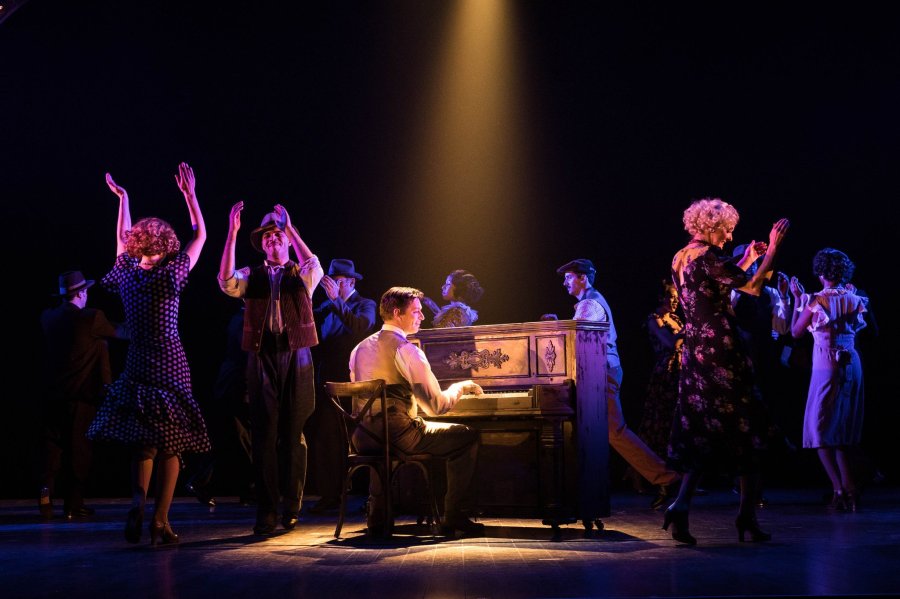It’s considered a faux pas in critical circles to suggest how a show could improve.
Us evaluators of all things theatre are supposed to stick to assessing what does and doesn’t work, leaving how to fix the latter to the professionals.
But when it comes to pre-Broadway tryouts, I simply can’t turn off the part of my brain that I once used while working as an Associate Producer for a Great White Way impresario. In that position, my reaction to shows transitioned from the conventional “Is this good — why or why not?” to “Will this make money, and what can we change to maximize profits?”
That was the question on my mind while watching the Paper Mill Playhouse’s musical adaptation of The Sting. The title alone basically screams the venture’s Broadway aspirations.
Unfortunately, the only way to significantly improve it is through some fundamental alterations, which can’t be achieved if the next step is Broadway. Though creatives love to talk about their overhauls, shows rarely take the leap before a near-finished version plays to adoring audiences far from the eyes of New York critics who sometimes possess the power to torpedo the best intentions with a stroke of their keyboards.
If The Sting‘s producers want to sting the Great White Way soon, my only “realistic” note— though it’s still a lot — is to recast J. Harrison Ghee, who plays Hooker (Robert Redford in the film; screenwriter David S. Ward initially envisioned the role as African-American, which assumedly didn’t happen because, well, racism. The character’s race is so integral to this translation that those unfamiliar with the original would be surprised to see The Sundance Kid’s pearly-white skin). Ghee’s fine, but someone with more of a charismatic persona (like a Joshua Henry type) would really inject some needed vitality into the entire show.
As for his co-star, Harry Connick, Jr. isn’t my favorite actor in the world. He obviously sells tickets, but this crooner isn’t big enough to singlehandedly lead ANY show to success (as his last, short-lived outing on the main stem proved). Yes, people obviously love The Sting, but too many beloved properties have failed on Broadway without the goods.
And in its current form, there’s just nothing remarkable about this Sting, besides Tony Award-winner Warren Carlyle’s choreography (which would be destined for another nomination at least), and the horse-racing songs (describing them would be a spoiler), which are some of the few inventive moments in the score by Urinetown‘s Mark Hollman and Greg Kotis, with additional contributions by Connick. Even so, the music is good enough. As for the book by Bob Martin, it can’t hold a candle to The Drowsy Chaperone, his current claim to fame.
But qhe quality of the writing isn’t the problem so much as the sheer volume of writing; it’s just toooooooo daaaaaaaaamn looooooong. I like the parallels drawn between putting on a show and putting on a con…but along that same vein, the show should reflect the rush of the con, which is virtually impossible to sustain over THREE HOURS. I understand the desire to humanize Ghee and Connick by focusing on their love interests, but I’d cut both (particularly aaaaaaaaaall the songs featuring Janet Dacal’s waitress). We don’t need to know about their personal lives to root for them.
As such, each scene should forward the plot of the sting and the sting alone; everything else should go (in other words, most of Act 2). Make it a 90-105 minute rocket ship, with even more nonstop dancing to keep up the musical energy, leaving the audience no time to get their bearings as the con relentlessly unfolds. It could be a sleek, speedy exercise in style over substance (which sounds a ton like a con too, thus emphasizing the aforementioned thematic connections).
Again, these are radical shakeups that would need to be tested in another pre-Broadway tryout before hitting the big time. If that’s not in the cards (pun intended), I hope very few other people feel the same way as I do about the shape it’s in. We need more new musicals on Broadway, even if they’re unoriginal both in material and execution.
